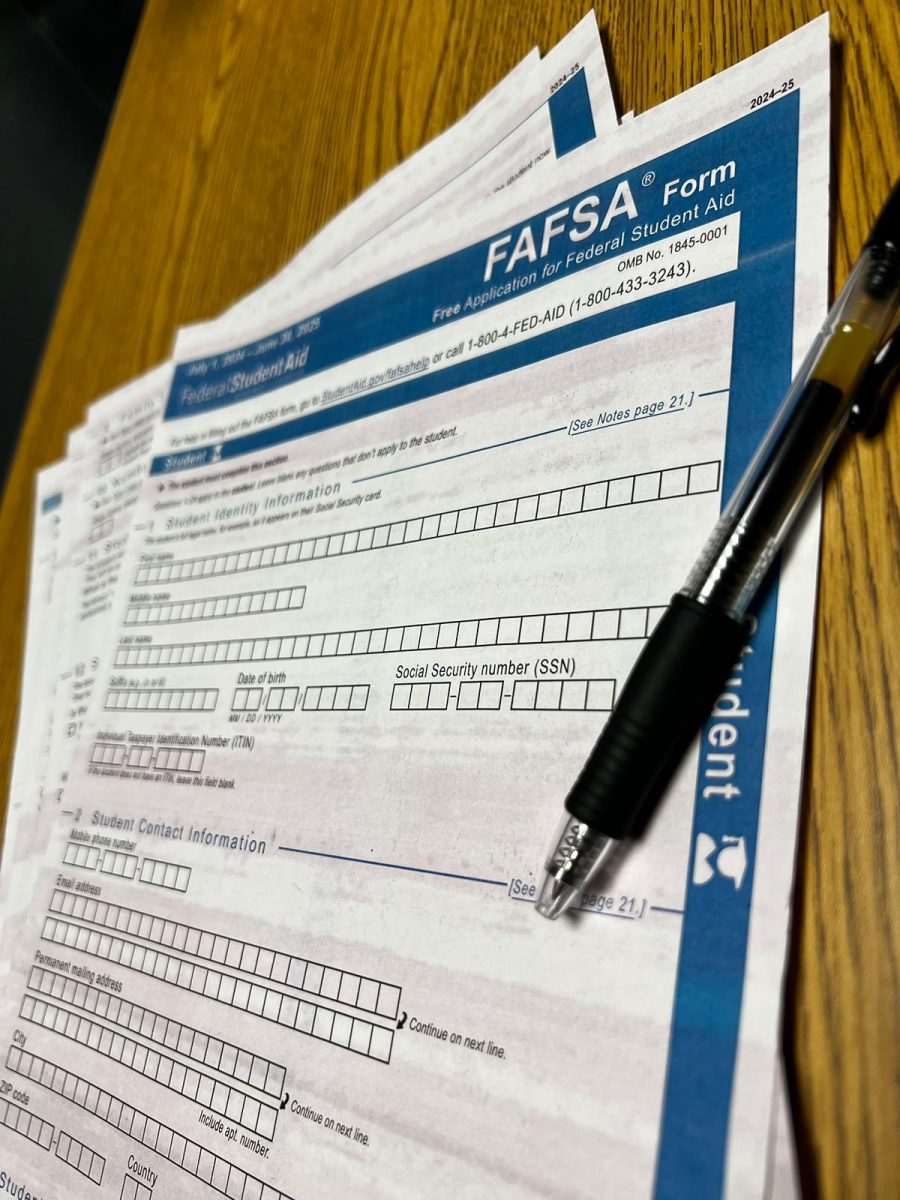When applying for college, the last thing any family wants is to question whether they will be able to have their finances in order on time for important deadlines and decisions.
The goal for the recent FAFSA was to redesign the entire infrastructure, including reducing the number of questions, removing barriers and broadening eligibility for financial aid.
The Free Application for Federal Student Aid (FAFSA), a free form that students need to complete to receive federal financial aid such as grants, loans and work study funds, is meant to make these aspects of applying to college easier. However, over the past few years, it has become increasingly difficult and has left families scrambling to figure out how to finish applications on time, – and with FAFSA’s recent attempts at redesigning the form, this difficulty has only worsened.
According to the U.S. Department of Education, the formula for the FAFSA form is being completely rewritten to make it easier for students to afford college through the FAFSA Simplification Act. This is the largest change they have made to the form in decades, requiring them to retire dozens of systems, some of which are 50 years old.
“We are simplifying and streamlining the FAFSA form to make it easier than ever to apply and afford college. We’ve done all of this with flat funding from Congress. They set deadlines for three major projects – the return to repayment, the FAFSA, and new student loan servicing contracts – within six months of each other and without any new funding,” wrote Jim Bradshaw, a representative from the U.S. Department of Education.
Previous changes to the FAFSA were just annual updates that required little time. However, the recent changes require more time than the usual updates, which was not given. The U.S. Department of Education was only given 15 months to achieve its goals, says Mark Kantrowitz, a student financial aid expert and founder of the FinAid website.
“It seems like there weren’t any plans for adequate testing,” said Kantrowitz. “As part of this process, U.S. Department of Education staff have been working 12 to 16 hour days to try to get this done.”
However, due to attempts to simplify the form, there have been delays in releasing it to the public. In the past, most FAFSA forms have opened in October, giving students plenty of time to have their forms ready by the time their school applications are due. This year, the form did not open until December 2023 and will close on June 30, 2024.
This can create an issue, as college commitment and enrollment deadlines often come at the end of each semester. FAU, for example, has an original deadline of May 1. When thousands of people are online trying to fill out their FAFSA forms at one time, sometimes the site crashes, further catalyzing the issues at hand.
“Universities are just now starting to receive a limited number of FAFSAs, a delay of over four months from prior years. Due to all these postponements, FAU, along with many other universities across the nation, are delaying the college decision deadline to May 15th from the traditional National College Decision Day deadline of May 1st,” wrote Ana Gagula, FAU’s director of student financial aid and enrollment management, in a statement.
Alongside the delays, the FAFSA form itself experienced many problems due to the number of changes being made. One of them was the FSA ID, which is the username and password the applicant uses to log into the FAFSA form and complete it.
An example of one of the issues with the FSA ID was for mixed status families, where one parent is a U.S. citizen and the other is not. If one parent indicated that they were a citizen, the form eliminated the option for the other parent to say that they were not. Due to this, students with parents who don’t have both social security numbers could not submit their FAFSA forms because it required a social security number from both parents.
Kantrowitz published an article discussing the pressure from Congress and the White House to fix the issues with FAFSA, which decided in January that they would make some adjustments and needed an additional six weeks to do so.
“I think that [the U.S. Department of Education] needed the additional six weeks also because of other problems with the new FAFSA, that the FSA ID in particular was having lots of problems for people who don’t have a social security number. And keep in mind that a student who is a U.S. citizen is eligible for Federal Student Aid, regardless of the citizenship status of their parents. And so they were trying to get FSA IDs, but there were a lot of bugs in the new system,” said Kantrowitz.
Eric Hoover, a senior writer for The Chronicle of Higher Education, posted an announcement on X on March 24, discussing the recent issues regarding the FSA ID.
“For the 2nd time this month, I just spoke with a frustrated mother with no Social Security number who was in tears as she described how she is STILL unable to complete the #FAFSA. 85 days after it went live,” the post reads.
For many families, especially low-income families relying on the Pell Grant and FAFSA aid, these delays can make applying for college exponentially harder. According to Allie Acrese, a spokesperson for the National Association of Student Financial Aid Administrators (NASFAA), wealthier students have the luxury of being able to decide on where to attend college, regardless of financial support, while students with greater financial needs do not.
“Students need the complete financial picture when making decisions about attending college, and they can’t do that without a financial aid offer from the schools they’ve applied to,” wrote Acrese. “Delays in delivering FAFSA applicant information to schools, state agencies and private scholarship providers have narrowed the window of time within which students must decide on where to enroll. That’s particularly concerning for the students most in need of need-based financial aid, and our hope is that with that information now flowing to colleges and universities, things will go smoothly from here on out.”
Alongside lower income students, first-generation students are also susceptible to being impacted negatively by the issues and delays with FAFSA. They experience a narrower window of opportunities based on their level of financial needs. A smaller variety of colleges to attend as well as the lack of time to make these important decisions, could discourage many of these students from attending college at all.
“The FAFSA was created to provide access to higher education for all eligible students,” wrote Tamsyn French, the director of financial aid and student success at FAU, in a statement. Without the FAFSA, many students would be locked out of post-secondary education and would not have the opportunity to pursue a college degree. The FAFSA is most critical for students with the least amount of financial resources because it may be their only pathway to higher education. For at-risk students, these current FAFSA issues could derail their entire future and reduce their ability to escape generational poverty.”
For Arianna Davis, a sophomore member of the Finance Students Association and a first-generation student, attending FAU is something she is very passionate about and to do so, she has taken on multiple jobs to meet financial requirements.
“I am a low income student as well as a first-generation student. I think that they should be more on top of these issues because it would take off a little bit of the stress people are experiencing. It takes so long for the information to be put into my account, even taking as long as getting my refund in the second summer term which is crazy,” said Davis.
Joudeline Jeanlis, another first-generation student at FAU, experienced problems with being unable to submit her FAFSA once she got to the point of a parent signing. She stated that it took an extra two weeks to complete the form due to this.
According to French, FAU has incorporated several strategies to aid students who have experienced issues due to financial aid, including:
- Posting recurring social media posts throughout spring 2024 to encourage FAFSA submissions.
- Offering virtual one-on-one workshops for current FAU students and first-generation students.
- Postponing original May 1 deadline to May 15 for incoming freshmen.
- Visiting local high schools and community organizations to facilitate FAFSA completion workshops and financial aid “101” sessions.
- Sending proactive email communications to incoming freshmen to complete the 2024-2025 FAFSA.
French also stated that the financial aid office will continue to email current students with the same information. All students have a dedicated financial aid counselor to assist with questions or concerns.
According to Kantrowitz, this is the first time that issues such as these have occurred for Federal Student Aid. Previously, when issues arose, they were resolved very quickly. Currently, there are over ten unresolved issues listed on the FAFSA website.
As students continue to have negative experiences with this process, the number of people who enroll in schools may decrease. Kantrowitz stated that the rate of FAFSA applications this year compared to last year is predicted to decrease 15% by August. This implies that fewer students are enrolling in colleges and universities.
“Students that are first in their family to attend college and low income families experience a lot of barriers while applying and enrolling in schools and this just gives the parents and students another reason to not consider going to college,” said Kantrowitz.
The loss of profit from enrollments can cause schools to lack the ability to catch up with their required funding, leading to the shutdown of many colleges and universities nationwide.
“The future of our economy depends on having a skilled and educated workforce, whether that’s achieved through obtaining a career and technical credential or a bachelor’s degree. Higher education opens the doors of opportunity, and financial aid holds that door open for those who otherwise might not have been able to choose that path,” wrote Acrese. “Ensuring the FAFSA operates effectively and is accessible to all students is directly related to advancing our workforce and our country. This process can’t just work for some; it must work for all students hoping to pursue a postsecondary credential or degree.”
Madison Denizard is a contributing writer for the University Press. For more information on this article or others, you can reach Madison at [email protected]



















